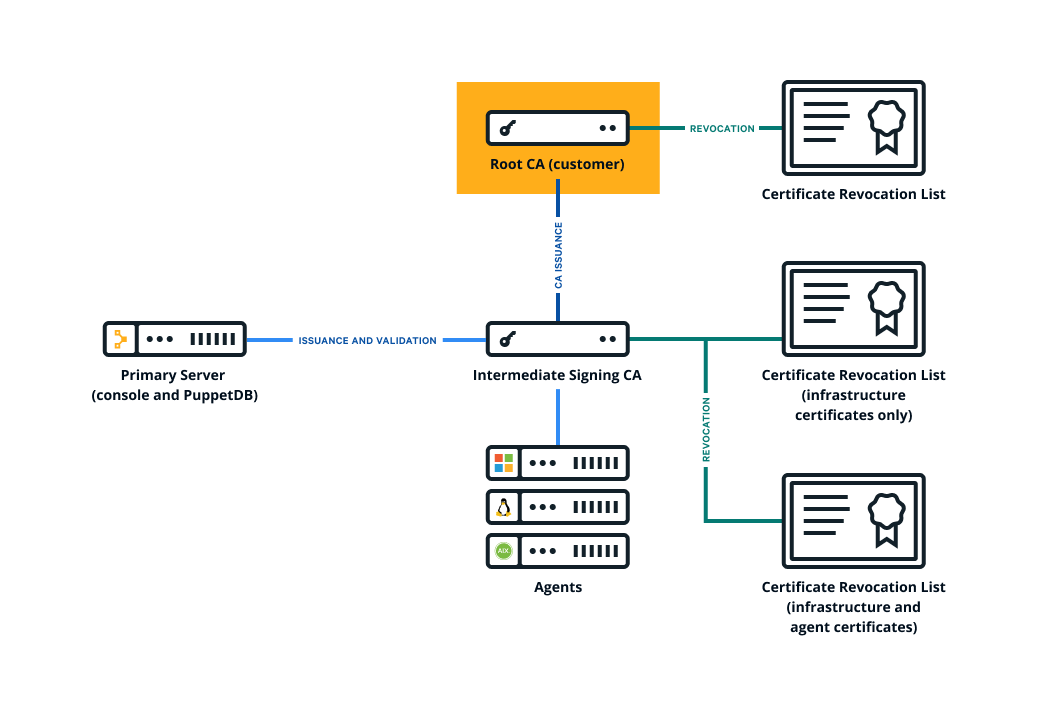The built-in Puppet certificate authority automatically
generates a root and intermediate certificate, but if you need additional intermediate
certificates or prefer to use a public authority CA, you can set up an independent
intermediate certificate authority. You must complete this configuration during installation.
CAUTION: This method requires more manual maintenance than the default
certificate authority setup. With an external chain of trust, you must monitor for and
promptly update expired CRLs, because an expired CRL anywhere in the chain causes
certificate validation failures. To manage an external CRL chain:
- Take note of the
Next Update dates of the CRLs
for your entire chain of trust.
- Submit updated CRLs to Puppet Server using the Certificate Revocation List
endpoint.
- Configure agents to download CRL updates by setting
crl_refresh_interval in the puppet_enterprise::profile::agent class.
-
Collect the PEM-encoded certificates and CRLs for your organization's chain of
trust, including the root certificate, any intermediate certificates, and the signing
certificate. (The signing certificate might be the root or intermediate certificate.)
-
Create a private RSA key, with no passphrase, for the Puppet CA.
-
Create a PEM-encoded Puppet CA certificate.
-
Create a CSR for the Puppet CA.
-
Generate the Puppet CA certificate by signing
the CSR using your external CA.
Ensure the CA constraint is set to true and the keyIdentifier is composed of the 160-bit SHA-1 hash of the value
of the bit string subjectPublicKeyfield. See
RFC 5280 section 4.2.1.2 for details.
-
Concatenate all of the certificates into a PEM-encoded certificate bundle, starting
with the Puppet CA cert and ending with your root
certificate.
-----BEGIN CERTIFICATE-----
<PUPPET CA CERTIFICATE>
-----END CERTIFICATE-----
-----BEGIN CERTIFICATE-----
<OPTIONAL INTERMEDIATE CA CERTIFICATES>
-----END CERTIFICATE-----
-----BEGIN CERTIFICATE-----
<ROOT CA CERTIFICATE>
-----END CERTIFICATE-----
-
Concatenate all of the CRLs into a PEM-encoded CRL chain, starting with any
optional intermediate CA CRLs and ending with your root certificate CRL.
-----BEGIN X509 CRL-----
<OPTIONAL INTERMEDIATE CA CRLs>
-----END X509 CRL-----
-----BEGIN X509 CRL-----
<ROOT CA CRL>
-----END X509 CRL-----
Tip: The PE installer automatically
generates a Puppet CRL during installation, so you
don't have to manage the Puppet CRL
manually.
-
Copy your CA bundle (from step 4), CRL chain (from step 5), and
private key (from step 2) to the node where you're installing the primary server.
Tip: Allow access to your private key only from the PE installation process, which runs as
root.
-
Install PE using a customized
pe.conf file with signing_ca parameters:
./puppet-enterprise-installer -c
<PATH_TO_pe.conf>
In your customized
pe.conf file, you must include
three keys for the
signing_ca parameter:
bundle,
crl_chain, and
private_key.
{
"pe_install::signing_ca": {
"bundle": "/root/ca/int_ca_bundle"
"crl_chain": "/root/ca/int_crl_chain"
"private_key": "/root/ca/int_key"
}
}
-
Optional:
Validate that the CA is working by running
puppet agent
-t and verifying your intermediate CA with OpenSSL.
openssl x509 -in /etc/puppetlabs/puppet/ssl/ca/signed/<HOSTNAME>.crt
-text -noout
Certificate:
Data:
Version: 3 (0x2)
Serial Number: 1 (0x1)
Signature Algorithm: sha256WithRSAEncryption
Issuer: CN=intermediate-ca
...
